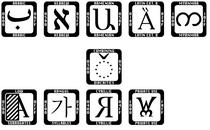| Thursday, June 6, 2002 |
03:29 - Multilingual Fun
|
(top)  |
"Brian! You took Spanish in high school, right?"
It was about 5:00 PM, and Richard was bearing down on my cubicle with that hopeful grin and desperate eyes of a man who has to call back a customer in Spain to tell him that he's ready to load the new upgraded software image onto his device and reboot it remotely, and whose only Spanish-speaking customer-ops guy had just gone home for the day.
"Uh... yeah...."
It's been seven or eight years since I've used Spanish in any practical context. I've never had the occasion, other than to listen to internal conversation of the people working at Taco Bell and to thank them when I hear them putting the proper funky decals on my complicated household-wide order. "Gracias!" I'd say, and they'd spin around, utterly startled that I could understand them and that I was paying attention.
So I was recruited to call up this guy in Spain, who spoke no English, and tell him "Hi-- we're ready to reboot the unit now and install the new image." Ya estamos listos para... er... umm.... What's "reboot" in Spanish?
Richard had the bright idea of switching one of our computers to Spanish and looking in the menus. He grabbed my Windows box and started -- well... he started out looking very purposeful and confident, but he was soon floundering and lost. Meanwhile, I fired up System Prefs in OS X, dragged Español to the top of the "preferred languages" list, quit it and reopened the app, and looked under the Apple menu, whose members were now all in Spanish. "Ah," I said. "Reiniciar."
So I call the guy up, I walk him through the reboot process in Spanish that comes freakily back to me on demand out of the depths of my brain, and we hang up amicably having done the necessary deed. At the very least, we seem not to have created an international incident. So that's good.
Anyway, this brought us into a curiosity-which-reinicié-the-cat exploration of Windows and how to change the default language. (We couldn't leave bad enough alone.) We found that the closest thing to it is the "Regional Settings" control panel, which baffled us with its odd terminology (what user has any idea what a "locale" is?), its half-explained controls and menus ("Your system is configured to read and write documents in multiple languages." That's nice. What in hell does it have to do with this list of languages with checkboxes next to them? What does checking them do? Who knows?), its impenetrably named code-page templates, and its seven or eight different places to do anything and everything. And nowhere in all this mess does it give you to understand that you don't even get any of those other languages for the OS interface; if you want Windows in Spanish, you have to install the Spanish version of Windows. Charming.
Whereas in OS X, it's all Unicode-based; so you simply drag the languages in the list into the order you prefer them in, and from then on any application you launch will go down that list until it finds a localized set of strings that matches your most preferred language, and uses that.
But that too got us thinking. I'd noticed that if you go to Google and select the "Language Tools", you get to see the Google interface in any of thirty or forty different languages, from Punjabi to Slovenian to Klingon to Elmer Fudd. Since we have Unicode fonts, we get to see things like Japanese, Russian, and Vietnamese in their native fonts, looking smooth and crisp, with all the letters beautifully rendered and accounted for.
But they're not all there. Not quite.
We couldn't help but notice that the Arabic page showed a bunch of weird, blurry squares. I'd never really paid much attention to this before; I'd assumed that it was just some kind of weird Unicode thing, a token that shows up differently in different displays. But then I noticed that the squares have what looks like an Arabic letter inside them.
Then I remembered that in the classic Mac OS, any undisplayable characters were shown as squares. So I thought, "I wonder"... and dragged a few of them over into TextEdit and cranked up the font size.

Look at that. It's squares, like always, for undisplayable characters. But now that it's all vector graphics, and because the Arabic font sets apparently aren't done yet (as they keep completing point releases of OS X, they keep adding character-set packs that fill out these blocks of letters), it's squares with cool information in them. The Unicode range that Arabic occupies, plus a central symbol to tell you what will eventually go there.
This is what it looks like when Apple isn't quite done with something.
So our curiosity was running rampant now; we switched into Unicode hex input mode (hold down Option and type four-digit hex numbers) and started entering values, to see what the ranges were like and what they were assigned to, and what symbols they had:

Mmm-mm. Isn't that insane? I love it. (And especially that Dr. Seuss-looking "Private Use" one.) Apple even makes unimplemented features look cool. These squares sit at the beginning of each block of assigned characters and define what that block is going to be, and if the characters haven't all been finished yet, they all show up as that generic identifier.
Oh, and depending on which letter you have selected, the available fonts in the font panel change. Select the Hangul character, and the six or seven dedicated Hangul fonts become available in the list.
There's always something bizarre and new lurking in an esoteric corner...
|
|


